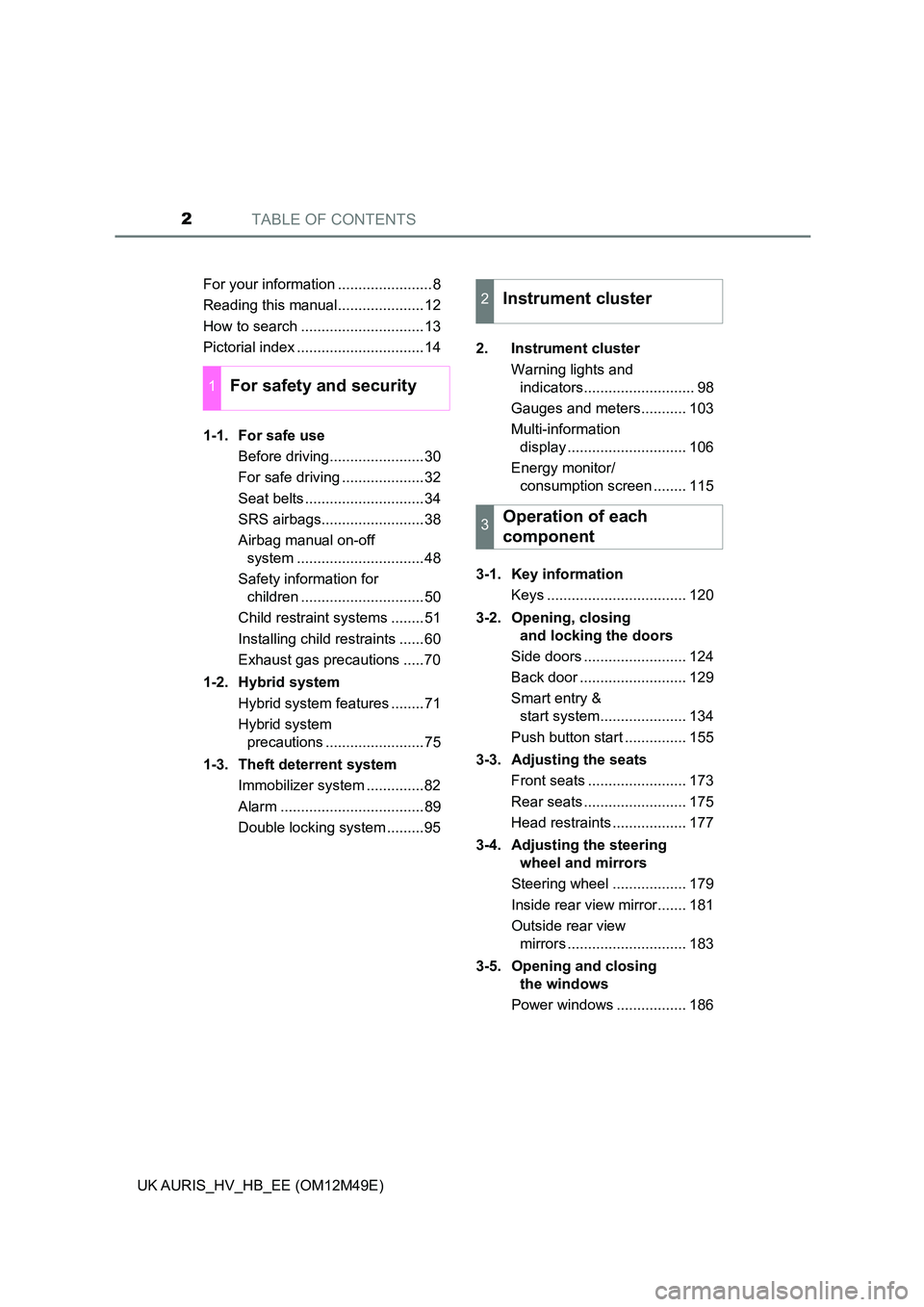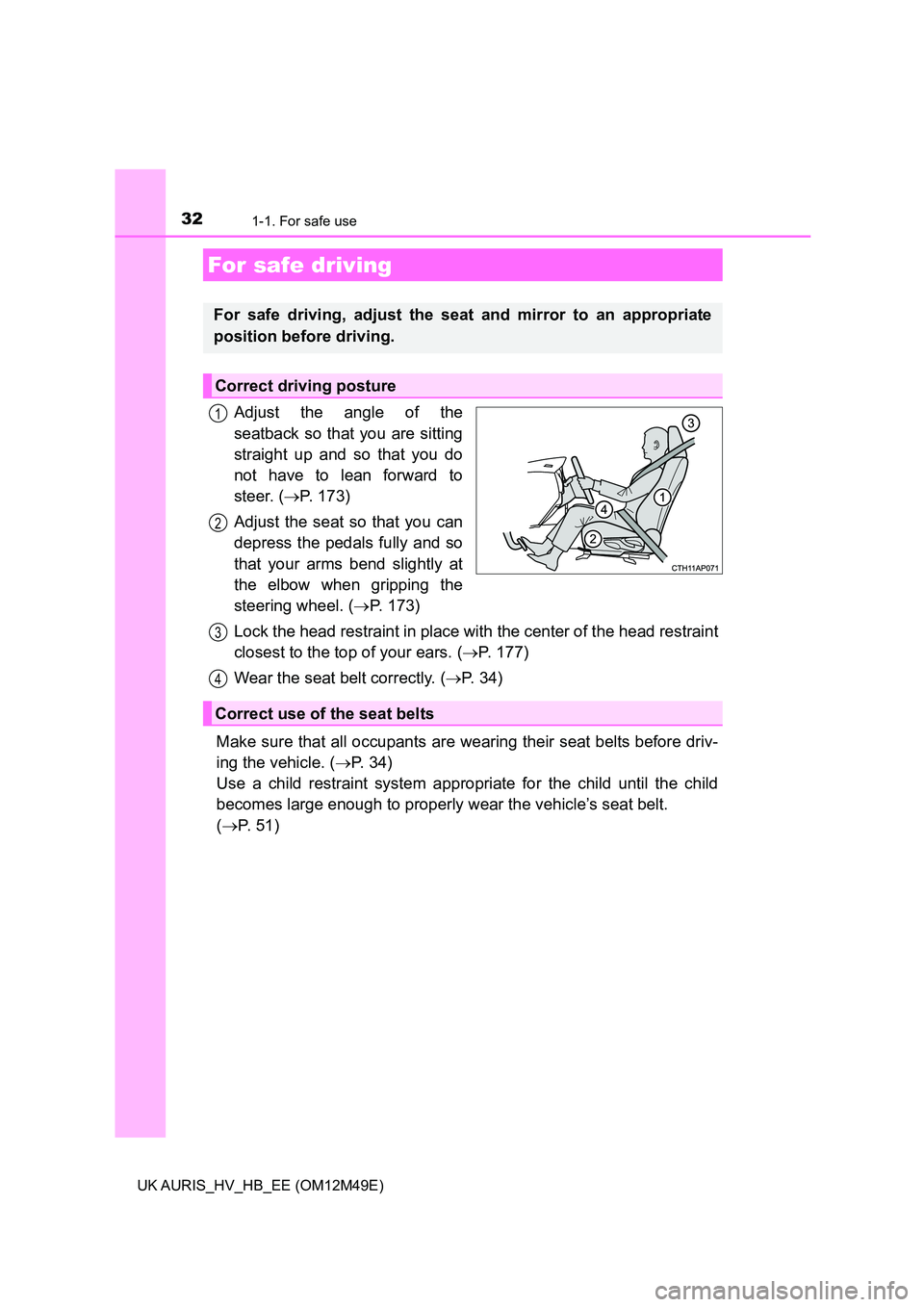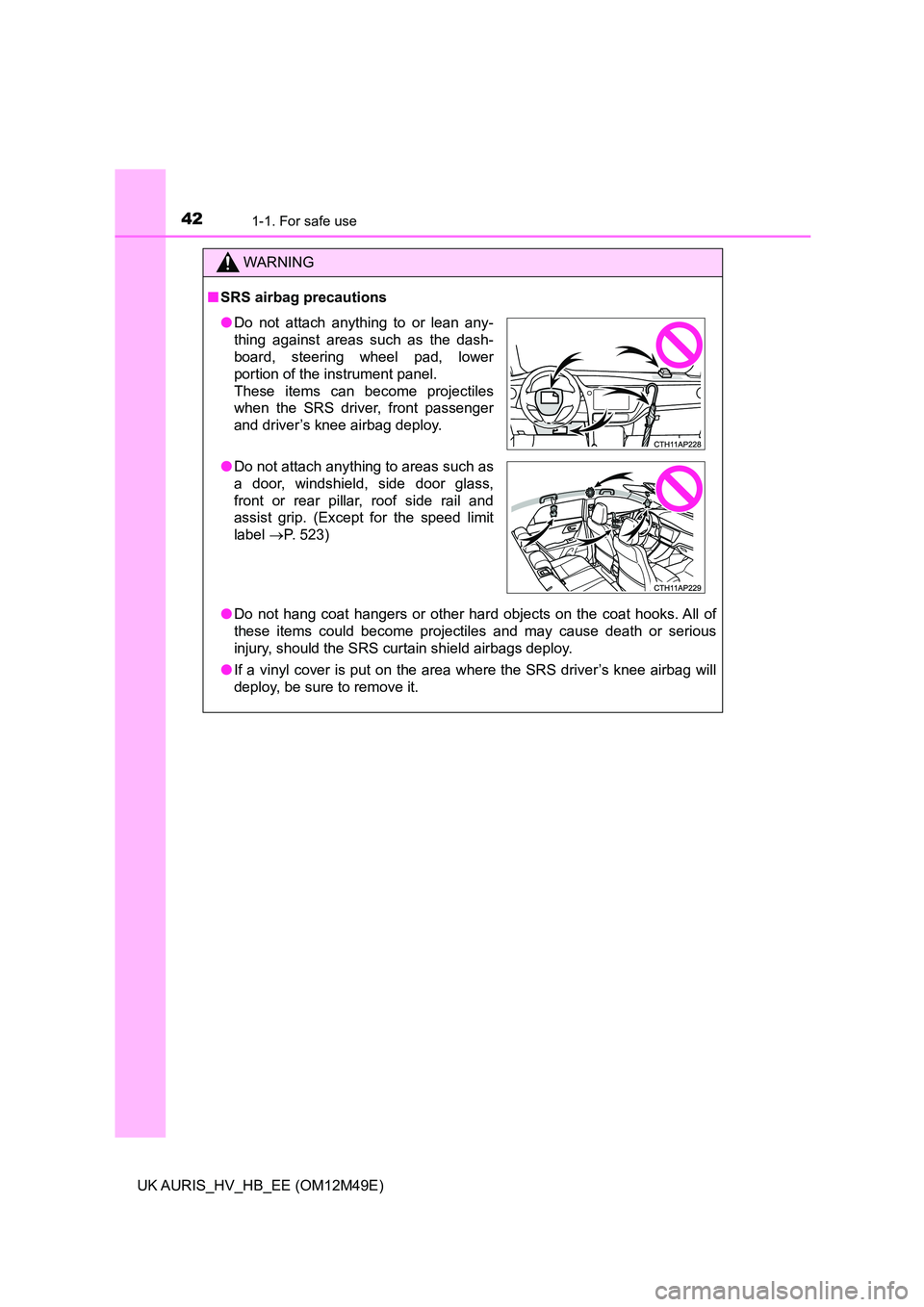2018 TOYOTA AURIS wheel
[x] Cancel search: wheelPage 2 of 592

TABLE OF CONTENTS2
UK AURIS_HV_HB_EE (OM12M49E)
For your information .......................8
Reading this manual.....................12
How to search ..............................13
Pictorial index ...............................14
1-1. For safe use
Before driving.......................30
For safe driving ....................32
Seat belts .............................34
SRS airbags.........................38
Airbag manual on-off
system ...............................48
Safety information for
children ..............................50
Child restraint systems ........51
Installing child restraints ......60
Exhaust gas precautions .....70
1-2. Hybrid system
Hybrid system features ........71
Hybrid system
precautions ........................75
1-3. Theft deterrent system
Immobilizer system ..............82
Alarm ...................................89
Double locking system .........95
2. Instrument cluster
Warning lights and
indicators........................... 98
Gauges and meters........... 103
Multi-information
display ............................. 106
Energy monitor/
consumption screen ........ 115
3-1. Key information
Keys .................................. 120
3-2. Opening, closing
and locking the doors
Side doors ......................... 124
Back door .......................... 129
Smart entry &
start system..................... 134
Push button start ............... 155
3-3. Adjusting the seats
Front seats ........................ 173
Rear seats ......................... 175
Head restraints .................. 177
3-4. Adjusting the steering
wheel and mirrors
Steering wheel .................. 179
Inside rear view mirror....... 181
Outside rear view
mirrors ............................. 183
3-5. Opening and closing
the windows
Power windows ................. 186
1For safety and security
2Instrument cluster
3Operation of each
component
Page 4 of 592

TABLE OF CONTENTS4
UK AURIS_HV_HB_EE (OM12M49E)
5-1. Basic Operations
Audio system types............318
Steering wheel audio
switches ...........................319
AUX port/USB port.............320
5-2. Using the audio system
Optimal use of the audio
system .............................321
5-3. Using the radio
Radio operation .................323
5-4. Playing audio CDs
and MP3/WMA discs
CD player operation ...........326
5-5. Using an external
device
Listening to an iPod ...........334
Listening to a USB
memory device ................342
Using the AUX port ............349
5-6. Using Bluetooth®
devices
Bluetooth® audio/
phone .............................. 350
Using the steering
wheel switches ................ 355
Registering a
Bluetooth® device ........... 356
5-7. “SET UP” menu
Using the “SET UP” menu
(“Bluetooth” menu) .......... 357
Using the “SET UP” menu
(“Phone” menu) ............... 362
5-8. Bluetooth® Audio
Operating a Bluetooth®
enabled portable
player .............................. 367
5-9. Bluetooth® Phone
Making a phone call .......... 370
Receiving a phone call ...... 372
Speaking on the phone ..... 373
5-10. Bluetooth®
Bluetooth®......................... 375
5Audio system
Page 6 of 592

TABLE OF CONTENTS6
UK AURIS_HV_HB_EE (OM12M49E)
7-1. Maintenance and care
Cleaning and protecting
the vehicle exterior ..........412
Cleaning and protecting
the vehicle interior ...........416
7-2. Maintenance
Maintenance
requirements....................419
7-3. Do-it-yourself
maintenance
Do-it-yourself service
precautions ......................422
Hood ..................................424
Positioning a floor jack .......426
Engine compartment..........427
12-volt battery ....................434
Tires ...................................439
Tire inflation pressure ........453
Wheels ...............................455
Air conditioning filter ..........457
Electronic key battery ........459
Checking and replacing
fuses ................................462
Light bulbs .........................467
8-1. Essential information
Emergency flashers .......... 482
If your vehicle has
to be stopped
in an emergency ............. 483
8-2. Steps to take
in an emergency
If your vehicle needs
to be towed ..................... 484
If you think something
is wrong........................... 490
If a warning light turns on
or a warning buzzer
sounds ............................ 491
If a warning message
is displayed ..................... 498
If you have a flat tire
(vehicles with
a spare tire) ..................... 507
If you have a flat tire
(vehicles with
an emergency tire
puncture repair kit) .......... 519
If the hybrid system will
not start ........................... 534
If the electronic key
does not operate
properly ........................... 536
If the 12-volt battery
is discharged ................... 539
If your vehicle
overheats ........................ 544
If the vehicle becomes
stuck................................ 549
7Maintenance and care8When trouble arises
Page 32 of 592

321-1. For safe use
UK AURIS_HV_HB_EE (OM12M49E)
Adjust the angle of the
seatback so that you are sitting
straight up and so that you do
not have to lean forward to
steer. ( P. 173)
Adjust the seat so that you can
depress the pedals fully and so
that your arms bend slightly at
the elbow when gripping the
steering wheel. ( P. 173)
Lock the head restraint in place with the center of the head restraint
closest to the top of your ears. ( P. 177)
Wear the seat belt correctly. ( P. 3 4 )
Make sure that all occupants are wearing their seat belts before driv-
ing the vehicle. ( P. 3 4 )
Use a child restraint system appropriate for the child until the child
becomes large enough to properly wear the vehicle’s seat belt.
( P. 51)
For safe driving
For safe driving, adjust the seat and mirror to an appropriate
position before driving.
Correct driving posture
1
2
Correct use of the seat belts
3
4
Page 40 of 592

401-1. For safe use
UK AURIS_HV_HB_EE (OM12M49E)
WARNING
■SRS airbag precautions
Observe the following precautions regarding the SRS airbags.
Failure to do so may cause death or serious injury.
● The driver and all passengers in the vehicle must wear their seat belts
properly.
The SRS airbags are supplemental devices to be used with the seat belts.
● The SRS driver airbag deploys with considerable force, and can cause
death or serious injury especially if the driver is very close to the airbag.
Since the risk zone for the driver’s airbag is the first 50 - 75 mm (2 - 3 in.)
of inflation, placing yourself 250 mm (10 in.) from your driver airbag pro-
vides you with a clear margin of safety. This distance is measured from
the center of the steering wheel to your breastbone. If you sit less than
250 mm (10 in.) away now, you can change your driving position in sev-
eral ways:
• Move your seat to the rear as far as you can while still reaching the ped-
als comfortably.
• Slightly recline the back of the seat.
Although vehicle designs vary, many drivers can achieve the 250 mm
(10 in.) distance, even with the driver seat all the way forward, simply by
reclining the back of the seat somewhat. If reclining the back of your
seat makes it hard to see the road, raise yourself by using a firm, non-
slippery cushion, or raise the seat if your vehicle has that feature.
• If your steering wheel is adjustable, tilt it downward. This points the
airbag toward your chest instead of your head and neck.
The seat should be adjusted as recommended above, while still maintain-
ing control of the foot pedals, steering wheel, and your view of the instru-
ment panel controls.
● The SRS front passenger airbag also deploys with considerable force, and
can cause death or serious injury especially if the front passenger is very
close to the airbag. The front passenger seat should be as far from the
airbag as possible with the seatback adjusted, so the front passenger sits
upright.
● Improperly seated and/or restrained infants and children can be killed or
seriously injured by a deploying airbag. An infant or child who is too small
to use a seat belt should be properly secured using a child restraint sys-
tem. Toyota strongly recommends that all infants and children be placed in
the rear seats of the vehicle and properly restrained. The rear seats are
safer for infants and children than the front passenger seat. ( P. 51)
Page 42 of 592

421-1. For safe use
UK AURIS_HV_HB_EE (OM12M49E)
WARNING
■SRS airbag precautions
● Do not hang coat hangers or other hard objects on the coat hooks. All of
these items could become projectiles and may cause death or serious
injury, should the SRS curtain shield airbags deploy.
● If a vinyl cover is put on the area where the SRS driver’s knee airbag will
deploy, be sure to remove it.
● Do not attach anything to or lean any-
thing against areas such as the dash-
board, steering wheel pad, lower
portion of the instrument panel.
These items can become projectiles
when the SRS driver, front passenger
and driver’s knee airbag deploy.
● Do not attach anything to areas such as
a door, windshield, side door glass,
front or rear pillar, roof side rail and
assist grip. (Except for the speed limit
label P. 523)
Page 43 of 592

431-1. For safe use
1
For safety and security
UK AURIS_HV_HB_EE (OM12M49E)
WARNING
■SRS airbag precautions
● Do not use seat accessories which cover the parts where the SRS side
airbags inflate as they may interfere with inflation of the airbags. Such
accessories may prevent the side airbags from activating correctly, disable
the system or cause the side airbags to inflate accidentally, resulting in
death or serious injury.
● Do not strike or apply significant levels of force to the area of the SRS
airbag components.
Doing so can cause the SRS airbags to malfunction.
● Do not touch any of the component parts immediately after the SRS
airbags have deployed (inflated) as they may be hot.
● If breathing becomes difficult after the SRS airbags have deployed, open a
door or window to allow fresh air in, or leave the vehicle if it is safe to do
so. Wash off any residue as soon as possible to prevent skin irritation.
● If the areas where the SRS airbags are stored, such as the steering wheel
pad and front and rear pillar garnishes are damaged or cracked, have
them replaced by any authorized Toyota dealer or repairer, or another duly
qualified and equipped professional.
■ Modification and disposal of SRS airbag system components
Do not dispose of your vehicle or perform any of the following modifications
without consulting any authorized Toyota deal er or repairer, or another duly
qualified and equipped professional. The SRS airbags may malfunction or
deploy (inflate) accidentally, causing death or serious injury.
● Installation, removal, disassembly and repair of the SRS airbags
● Repairs, modifications, removal or replacement of the steering wheel,
instrument panel, dashboard, seats or seat upholstery, front, side and rear
pillars or roof side rails
● Repairs or modifications of the front fender, front bumper, or side of the
occupant compartment
● Installation of a grille guard (bull bars, kangaroo bar, etc.), snow plows or
winches
● Modifications to the vehicle’s suspension system
● Installation of electronic devices such as mobile two-way radios (RF-trans-
mitter) and CD players
● Modifications to your vehicle for a person with a physical disability
Page 44 of 592

441-1. For safe use
UK AURIS_HV_HB_EE (OM12M49E)
■If the SRS airbags deploy (inflate)
● Slight abrasions, burns, bruising etc., may be sustained from SRS airbags,
due to the extremely high speed deployment (inflation) by hot gases.
● A loud noise and white powder will be emitted.
● Parts of the airbag module (steering wheel hub, airbag cover and inflator) as
well as the front seats, parts of the front and rear pillars, and roof side rails
may be hot for several minutes. The airbag itself may also be hot.
● The windshield may crack.
■ SRS airbag deployment conditions (SRS front airbags)
● The SRS front airbags will deploy in the event of an impact that exceeds the
set threshold level (the level of fo rce corresponding to an approximately 20 -
30 km/h [12 - 18 mph] frontal collision with a fixed wall that does not move or
deform).
However, this threshold velocity will be considerably higher in the following
situations:
• If the vehicle strikes an object, such as a parked vehicle or sign pole,
which can move or deform on impact
• If the vehicle is involved in an underride collision, such as a collision in
which the front of the vehicle “underrides”, or goes under, the bed of a
truck
● Depending on the type of collision, it is possible that only the seat belt
pretensioners will activate.
■ SRS airbag deployment conditions (SRS side and curtain shield airbags)
● The SRS side and curtain shield airbags will deploy in the event of an
impact that exceeds the set threshold level (the level of force corresponding
to the impact force produced by an approximately 1500 kg [3300 lb.] vehicle
colliding with the vehicle cabin from a direction perpendicular to the vehicle
orientation at an approximate speed of 20 - 30 km/h [12 - 18 mph]).
● The SRS curtain shield airbags will deploy in the event of a severe frontal
collision.